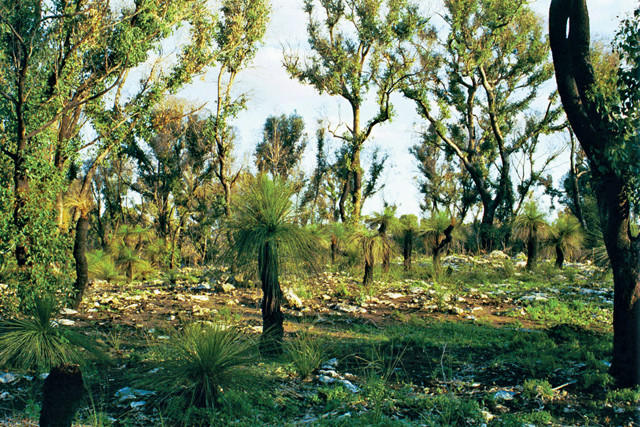
by Lauren Milideo Tuesday, October 18, 2016

The landscape above Yonderup Cave in Western Australia, after a wildfire. Credit: Pauline Treble.
Water seeps through soil and bedrock before dripping from the roof of a cave and carries with it elements of the outside world and its climate history. That is why speleothems, cave structures formed via precipitation, can be studied as climate proxies. New research suggests that the chemistry of the cave dripwater can also contain the signature of wildfires that burned outside the cave, on the ground above the cave’s roof, yielding a more complex picture of the past.
Researchers — including Pauline Treble, a geochemist at the Australian Nuclear Science and Technological Organization, and Gurinder Nagra, who was an undergraduate geochemistry student at the University of New South Wales in Sydney, Australia, when the study was conducted — studied cave dripwater collected for more than five years at two sites beneath different types of vegetation at Western Australia’s Yonderup Cave.
The team analyzed oxygen and hydrogen isotopes and trace elements, including calcium and chlorine. They were looking to compare oxygen isotope climate proxy data to regional, measured climate data in this semiarid region. Next, they modeled various climatic and hydrologic scenarios, based on regional data, to compare with their results. Finally, the researchers compared their results to Western Australia’s Golgotha Cave, which had not experienced wildfire in more than a decade. They reported their findings in Hydrology and Earth System Sciences.
Isotope ratios are affected by such factors as evaporation and transpiration, which is one of the reasons they are used as climate proxies. At Yonderup, researchers found a significant difference in the oxygen isotope ratios between the two sites, which shared a regional climate, and thus should have exhibited similar isotope ratios. Instead, Treble says, “the drip chemistry varied considerably between the two sites, suggesting that there were highly localized processes impacting the dripwater signal, and that hence they could not be interpreted as a broader climate signal.”
The team attributed the chemistry differences to the varied vegetation types, pre- and post-fire, above each collection site, which affected processes such as evaporation and transpiration. Golgotha Cave also showed less variable trace element signatures than the recently burned Yonderup Cave, suggesting that a recent fire had altered Yonderup’s two sites differently, a finding that strengthens the argument for wildfire’s impact on trace element data.
The study’s implications for the interpretation of the speleothem climate record are significant, Nagra says. If wildfires above caves can alter the oxygen isotope record, then scientists need to be careful how they interpret and use speleothem records in climate reconstructions.
The argument for trace element concentrations being affected by vegetation is sound, says Boston College geochemist Corinne Wong, who was not involved in the study.
“They’re trying to introduce a new proxy, which would be a way to reconstruct past fire events using cave deposits,” Wong says. However, she says, the lack of pre-wildfire data restricts interpretations. “It just points to the need for more studies of this nature, if this proxy is to be developed further.”
Nagra notes that a good next step would be to examine speleothems in an area with known fire records — for example, a national park — to see if the fire record can be observed in the cave formations.
© 2008-2021. All rights reserved. Any copying, redistribution or retransmission of any of the contents of this service without the expressed written permission of the American Geosciences Institute is expressly prohibited. Click here for all copyright requests.